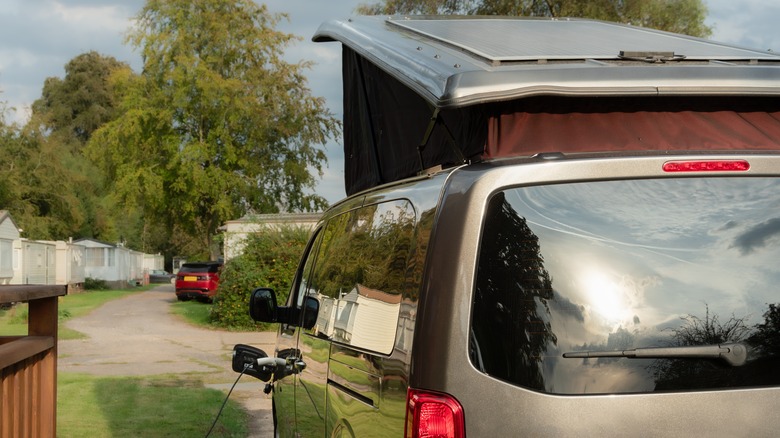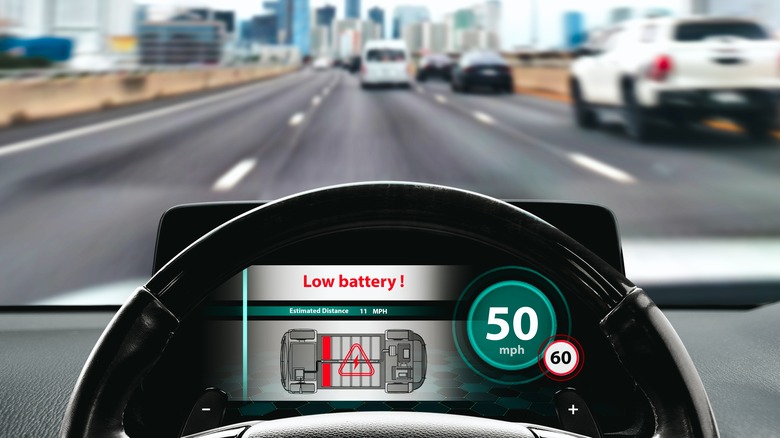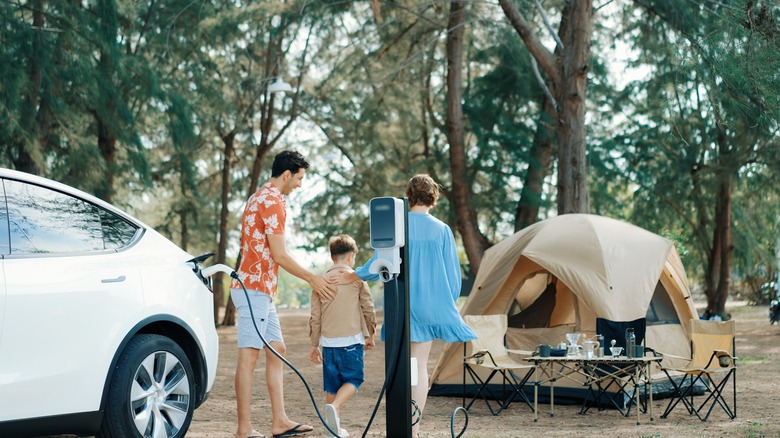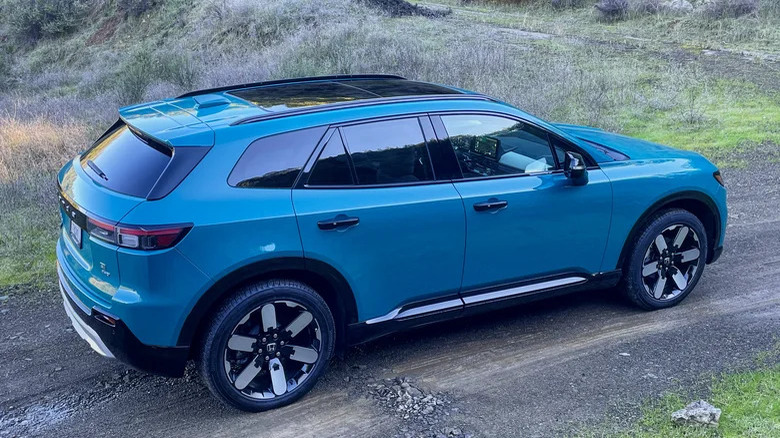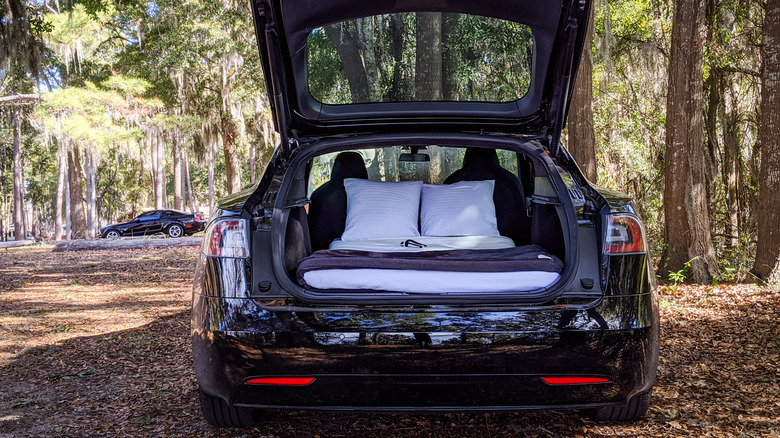5 Tips For Car Camping With An EV
Thanks to gradual improvements in electric vehicle technology and design, market niches that were previously the exclusive domain of gas-powered cars are gradually starting to open up. For example, if you wanted to go camping entirely out of your car, that would normally be a job for a beefy, gas-guzzler of a vehicle. As EVs catch up to regular cars in terms of rugged designs and motor performance, though, they too can handle the camping trail for a pleasant night out under the stars.
That said, while it is more than possible to go car camping in an EV, doing so does bring with it some particular considerations. There are some aspects of car camping that you might take for granted with a gas-powered vehicle, whereas driving an EV can make some subtle, yet important changes to the rules. It's all very doable, you just need to make a checklist and verify some information before you hit the road.
Double-check your EV's battery range
The first order of business is to check your EV's documentation and specs to get a firm idea of its precise driving range. If you try to take a camping trip that's decisively beyond your EV's stated traveling range, you're either going to run out of power midway along or not have enough juice to get you safely back home. Double-check your EV's stated range and pick a campsite that's well within that range. You want a spot you can comfortably reach and return from with juice to spare.
Additionally, remember that EVs are somewhat limited by the presence of charging stations along the road, either standalone ones or those present at a gas station. If you're going to need to venture out a bit, do some research on the route to see if there's a place you can stop to recharge, either on the way there or on the way back. If you're particularly lucky, the campsite you go to may have an EV charger available for public use, but you definitely shouldn't bank on it.
Make sure you're fully charged before you go
On the subject of batteries, in the same way that you should ensure a regular car is gassed up before taking a trip, you should make sure your EV's battery is fully charged before you depart for your camping adventure. Ideally, you won't need to make any detours on the road on the way to the campsite, and there will be chargers available on the road for you to use. However, you never know when traffic or an obstruction will force you to change your path, possibly for the longer, so you'll want a full battery to offset any unexpected power consumption.
As part of your camping packing, you should consider bringing along a portable electric generator, just in case of an emergency. If you're stranded at the campsite with an empty battery, or worse, on the side of the road, you'll be glad you had a portable means of power regeneration ready to deploy. However, be sure that the generator is compatible with your EV before hitting the road.
Check your EV's AWD settings and tires
Where all-wheel drive was previously the turf of hefty utility vehicles, it has now found its way to many modern EVs. There are EVs on the market that have AWD systems just as capable as you'd find on a gas-powered car, allowing them to surmount rough and uneven terrain. Of course, all of this is contingent on the assumption that your particular EV is equipped with AWD functionality. Double-check your EV's user manual to ensure that it's got an AWD system and, if it needs to be manually activated, how to toggle it on and off. If your EV can't handle uneven roads, it definitely shouldn't be used for camping out in the wilderness.
Additionally, you should give your EV's tires a once-over before you depart as well. After all, you can't make proper use out of an AWD system if you're rolling around on basic road tires. If you know you're going to be hitting the wild trail, it would behoove you to swap out your EV's standard tires for something with a little more grip. Great all-terrain tires will help you drive in and out of unpaved areas safely, which is a must if you're not staying at a commercial campsite.
Check if your EV has a dedicated camping mode
One of the cool things about EVs is that, since they're electronically-controlled, some of them have dedicated settings and modes for certain usage situations. Specifically, some EVs have a specialized camping mode designed to make them more comfortable to spend an extended period in. This is a feature you can find on certain Tesla vehicles, for example.
In the particular case of a Tesla's camping mode, engaging it helps to maintain temperature and airflow inside the vehicle, so the whole thing doesn't turn into a Dutch oven. It also allows you to use the infotainment system features for playing music and videos, as well as plug devices in to draw from the battery. Don't assume your EV has a camping mode, however, or that it works exactly like this. Carefully check your owner's manual to see which comfort or camp modes are available, and make sure you know exactly how to activate, deactivate, and manage them. Remember, using these kinds of modes can passively drain your EV's battery, especially if you leave them on all night, so consider turning them off when it's time for bed to conserve power.
Be mindful about how much stuff you bring and use at the campsite
Speaking of conservation, camping in an EV can be a bit of a balancing act of space and energy economy. EVs can be rather spacious, since they don't need to take up space with an engine and whatnot, so you might be tempted to bring along more gear and amenities than you normally would in a regular car. However, overpacking may prove detrimental to your EV's capabilities. Remember, an EV's specified range is based on certain assumptions of weight and capacity. If you overburden your EV with cargo, it'll need to expend more of its battery charge to carry all of it to and from the campsite, which could mess with your plans.
Additionally, if you were hoping to plug a bunch of assorted gadgets into your EV's battery, like a refrigerator or air conditioner, you might want to temper your expectations a bit. Plugging a couple of high-tech gadgets, like a phone charger or radio is fine, but if you try to set up an entire living room's worth of electronics at once, your EV will run out of juice in a flash. Keep both your cargo and energy usage expectations reasonable and realistic.
